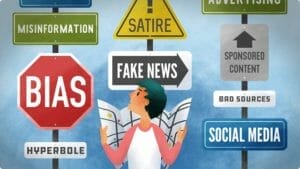Bias
Bias refers to any words that misrepresent the truth or paint a subject unfairly. Whether you are working on your essay or other writing assignments, it is essential to use trustworthy sources. Including a biased source in your work attracts criticism and lowers your credibility. To ensure the credibility of your sources, here are a few pointers to watch out for.

One-Sided Arguments
When an author is keen to portray one side of the divide in a particular manner and shape public opinion, you need to reconsider your choice. For instance, when comparing two institutions, you expect the writer to highlight the pros and cons of both and let the reader decide for themselves. A significant imbalance in the number of pros and cons is a red flag.
Lack of Evidence to Back Claims
Biased sources rarely include resources like research findings to substantiate their claims. They also lack citations to support their ideas. When an author presents some information as facts, it is only proper to include the right sources to clear doubts. The presence of generalizations within the text is a clear sign of bias. Factual statements are specific and easy to trace back to the source.
Insensitive Language
The type of language in a text easily reveals bias, and in extreme cases, the bias is loud and clear. Bias in language can relate to race, gender, age, disability, and even sexual orientation. Including biased words can make some sections of the people feel hurt and is downright unprofessional. For example, the word “homosexual” is offensive to affiliates of the LGBTQ movement. “Gay” is the recommended term when mentioning this group.
Omission of Important Information
Some authors omit important information from their cited works. As a result, this information risks misinterpretation. Omission bias can be costly in some sensitive areas like medicine, where an author may have a bias regarding topics like euthanasia or vaccination. Such bias can mislead readers and lead to suffering and exposure to life-threatening conditions. In politics, this kind of bias is rampant. It is essential to verify that your sources are credible.
Misquoting Sources
In some cases, authors misquote their sources for various reasons. One commonly misquoted area is in the field of statistics. Statistics make a significant difference in arguments, and they are prone to manipulation. Luckily, statistics are a result of research findings. These findings are usually posted online, and by comparing them with the original statistics, you can point out differences. Once an author alters such figures, there is no telling what else they have excluded in their work.
No Mention of Authors
Some publications do not cite authors, especially in the case of studies considered small. In some cases, authors deliberately leave out such information to stifle differing views and hide unfavorable findings. Such tactics are costly and lead to unnecessary authorship disputes. If you choose to include a source with no author, you may have to face the original author or contributors in court.
Inclusion of Obvious Errors
Most authors are keen to use correct grammar and proofread their work. They have an image to protect, and any errors could affect their credibility. Authors who show bias have little to no authority in their field, and their work may contain grammatical or spelling errors. Serious publications invest a lot of time and resources to ensure their work is error-proof.
Subjective Statements
Subjective statements may be factual or lack facts as they are a reflection of the author’s sentiments. They are acceptable in opinion pieces and marketing posts. However, if an online essay writer is working on academic papers, he or she cannot afford to include subjective statements. It is advisable to work with facts and use sources providing objective rather than personal views.
Reasons to Avoid Biased Sources
Avoiding biased sources is the first step to ensure that readers have access to factual information. Bias brings many undesirable outcomes, some of which are as follows:
Encourages Discrimination
Some authors use insensitive words to describe some segments of the population. This can cause a surge in cases of discrimination against such people.
Can Cause Costly Errors
Biased research findings or studies can lead to errors in judgment in some professions. These errors can be detrimental and lead to the unnecessary loss of lives or incapacitation.
Can Cause Unrest
Bias in reporting of events and news can lead to civil unrest among citizens. Politicians have been accused of splashing money to taint the image of their opponents. Also, sensationalist reporting about events like wars can aggravate the situation.
Encourages Misinformation
Past events have been put under the spotlight in recent times for bias. Historians have had to contend with past accounts laced with the author’s sentiments. Unfair accounts from the past are a thorn in the flesh for history lovers.
Conclusion
Bias affects many aspects of life, and it is best to avoid it. While it is not always possible to tell all instances when a source contains bias, it is possible to limit using such sources. With these guidelines, you can pick out fact-based sources with ease and maintain credibility.
Thomas Moore is an experienced online essay writer with huge expertise. Having previous experience in e-mail marketing in PR agency, he offers his insight and knowledge in this article. Thomas is a passionate content creator striving for quality in every piece.














